Grill family
The Grill family are noted for their contribution to the Swedish iron industry and for exports of iron and copper during the 18th century. Starting as silversmiths and experts on noble metals the Grills became engaged in a wide range of businesses. After 1700 the family began its rise to prominence. They owned ironworks, while operating wharfs, and importing material related to shipbuilding. The Grills benefited from mercantilist policy. With a positive balance on their account the Grills became engaged in banking, also in the Dutch Republic; around 1720 in the market for government liabilities and then mediating large credits and clearing international bills of exchange.[2] The Grills had significant influence with the Swedish East India Company (SOIC); three members became directors of the SOIC and the Grill firm traded as members of the SOIC and privately.
| Grill | |
|---|---|
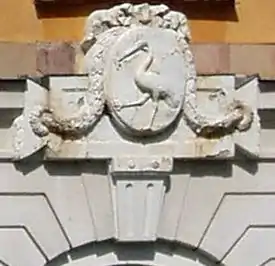 The Grill family coat of arms at the Österbybruk manor | |
| Place of origin | Augsburg, Germany |
| Members |
|
| Distinctions | Prominent in trade, mining, manufacturing, banking and politics |
| Estate(s) | Numerous during the 18th and 19th centuries |
Motto: Honesty is the best policy. | |

All the noted Grills were in some way connected to the main Grill Trading House and to each other. Some Grills married a relative, others helped their nephews into business. In this way the Grill name was kept and passed on through the generations.
Origin
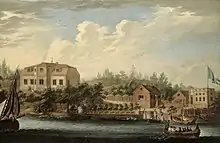
On 29 June 1571, Andreas Grill, burgher in Augsburg received burgher arms in a letters patent from a count palatine of the Holy Roman Empire.[5] The name Grill comes from the Italian Grillo, meaning cricket, while the family's coat of arms displays a crane holding a cricket in its nib.[lower-alpha 2]
The family came to Sweden with the arrival of the silversmith Anthoni Grill (I) in 1659. For more than 25 years Anthoni had lived in Amsterdam, but moved to Stockholm when he was appointed as the Riksguardie (the national appraiser) responsible for the quality of alloys and the accuracy of weights and measures, and the stock of precious metals used in minting. He was succeeded at the Myntverket by his son Anthoni Grill (II).[7]
During the 18th century the family was described as members of the Skeppsbroadeln (the Skeppsbro Nobility).[8] Abraham Grill had six sons who cooperated in business. The name referred to the wealthiest merchant families in Stockholm at that time, especially those who lived by the quays along the Skeppsbron.[9]
The family consisted of two branches —the Garphyttan branch, starting with Anthoni (IV) and the Godegård branch, with Jean Abraham Grill. Since 1911 the Grill family is included in the Ointroducerad Adels Förening (Association of the Unintroduced Nobility), an association for Swedish citizens whose family was ennobled in a foreign country, as well as some families who were ennobled in Sweden but for some reason never introduced at the Swedish House of Nobility.
Anthoni Grill (I)
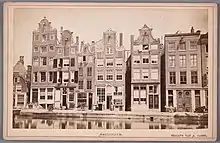
Anthonie Grill (1607–1675) was born in Augsburg as the son of goldsmith Balthasar Grill (1568–1614) and Rosina Schweigler.[10] The city was a centre of European silversmithery. During the Thirty Years' War, the Lutheran city was occupied by a Bavarian army but recaptured by the Swedish army in April 1632.[11] At some point, Anthoni and his brother Andries moved to Amsterdam. The two silversmiths both got married in January 1634,[12] and Andries for the second time in February 1640, who had then settled in The Hague. Their younger brother Johannes (I), a journeyman, got married in September 1645.[13][lower-alpha 3]
In December 1635, Anthoni promised his business partner[lower-alpha 4] to reveal a secret about smelting silver, which is generally found in a combined state in nature, usually with copper or lead. In 1637 and 1642 he took on and lodged two apprentices.[15] In 1638 he became a burgher of Amsterdam. In March 1651 Anthoni bought a property for 12,000 guilders between Looiersgracht and Passeerdersstraat. There Anthoni set up a number of laboratories or furnaces, testing fresh and recycled metals to ascertain their purity for jewellery and coin making. In 1653, Anthoni, somehow connected to or observed by members of the Hartlib Circle, cooperated in an alchemist project with his brother Andries. According to Johann Friedrich Schweitzer they used a hydrochloric acid.[16]
It is possible that a son of Michiel le Blon, a goldsmith, art dealer and agent for Christina, Queen of Sweden, informed the Swedish Board of Mines about Grill's experiments to extract precious metals from ore through the use of what Grill called a "secret matter". On 28 May 1658, this earned him the position of riksguardie, working for the Münzmeister at the Swedish Mint. He also got a 30-years patent on his "secret" extraction methods.[7] Anthoni moved to Stockholm after 10 June 1659. His silver smelting lab was rented out by Cornelis le Blon to the chemical engineer Johann Rudolf Glauber, until it was sold for 20,880 guilders on a foreclosure auction in January 1661.[16]
Grill continued his smelting experiments with cupellation of noble metals in Sweden.[17] With three companions he was allowed to conduct experiments with copper and lead from the Lövåsens silvermine in Stora Skedvi.[18] However, his methods were never successful and his work at the mint was substandard. His deficiencies at the mint were brought to light by Georg Stiernhielm in 1662, and the next year, his smelting methods were strongly criticized by the Board of Mines where its chairman, Erik Fleming,[lower-alpha 5] accused Grill of defaming him. In 1663, Grill was demoted to handling the weighing of precious metals and other "minor items and tasks", while Jöran Low became the new riksguardie.[7] in 1661 he introduced credit paper (Kreditivsedlar), the first European banknotes with copper as collateral.[19] The lack of silver, the cumbersome size and weight of copper plate money eventually prompted Sweden to become the first country in Europe to issue such notes.[lower-alpha 6] In 1624 Sweden had introduced a copper standard; in 1664 Sweden reintroduced the silver standard.[20]
Anthoni Grill (II)

Anthoni Grill (1639–1703) was the son of Anthoni Grill (I) and Catharina Staets.[lower-alpha 7] In 1664 he married Anna van Slingeland in Stockholm. Following in his father's footsteps, he was appointed riksguardie in 1667,[7] checking the quality of the silver. Grill had numerous reform proposals for the mining industry at Sala Silver Mine, and Stora Kopparberget, which produced 2/3 of the worlds copper.[21] His brother Baltasar, also worked at the Swedish Mint but as a skedare[lower-alpha 8] (lit. "spooner" meaning gold parter),[23][lower-alpha 9] and took part in Kungsholmen's glassworks in 1682.[24] In 1694 Anthoni became one of the shareholders of the Big City shipyard in Stockholm.[25] He participated in the gilding of the newly built northern wing of the Royal Palace.
After being widowed, Anna van Slingeland (−1714) moved from Gamla stan to Amsterdam, where several of her children lived.[lower-alpha 10] In 1716 Sophia Grill remarried – on a prenuptial agreement – Nikolaas Kohl, a tradesman on the Baltic, originating form Arensborg. On 10 August 1734, Kohl bought The Conspiracy of Claudius Civilis, for 60 guilders.[26] Originally 500 cm × 550 cm (200 in × 220 in), it was the largest work Rembrandt painted.[lower-alpha 11] The couple had a small estate near Zwammerdam, where Sophia died in August 1766.[lower-alpha 12][lower-alpha 13]
Anthoni Grill (III)
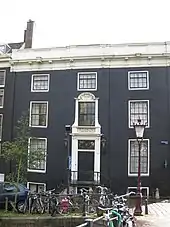
Anthoni Grill (1664–1727) returned to Amsterdam in 1686 and married his cousin Elisabeth Grill in 1693. He settled as silversmith in Kalverstraat, where the Grills owned a shop almost next to a hidden church.[lower-alpha 14] In December 1693 he was admitted as a private assayer.[30] Between 1702 and 1742 the Grills imported copper plates (c.q. plate money) from Sweden.[31] As Europe's copper supplier, Sweden exported copper and more so when the copper price was high, exporting their copper plate money as bullion.[32] In January 1711 Anthoni and Johannes Grill (III) were appointed as assayers at the Wisselbank. From 1713 onwards, the bank reported[lower-alpha 15] on their profits.[lower-alpha 16] Until 1725, on average, nearly half of the bank profit was attributable to the activities of ten assayers.[33] The Grills had no children and they started a courtyard with almshouses known as Grill's hofje.[10][34] They were both buried in the Oude Lutherse Kerk at Singel in Amsterdam. In 1728, his collection of fine paintings and rare objects was sold.[35][lower-alpha 17]
Abraham Grill (I) the Elder
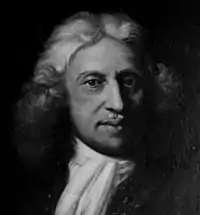
Abraham Grill (1674 – 20 March 1725) was a Swedish merchant. He was the son of Anthoni (II), a brother of Anthoni (III) as well as heir to the Grill family fortune in Sweden, which he increased through trade speculation. He married three times,[37] and had seven children[38]
From 1704 Abraham Grill cooperated with his brother-in-law Abraham Gemnich (1665–1711). In 1709 Sweden reintroduced the copper standard which was in use till 1766.[20] In 1715 the company bought reclaimed land, from Countess Elisabeth Oxenstierna, in the east part of Stockholm. The land was used to establish the Terra Nova wharf,[lower-alpha 18] also known as the Köpmannavarvet (the Merchants Wharf).[40] In 1716, he and his younger brother Carlos Grill, founded the Grill Trading House. The house traded mainly (90%) in wrought iron and became one of the leading trading houses in Stockholm during the 18th century.[41] In 1722 he acquired the iron works at Iggesund.[42]
During the Great Northern War led by King Charles XII, Abraham gave large sums of money to the state and during a time of famine he sold grains at reduced price to the needy. He was also the driving force behind the founding of a house for poor elderly widows in Stockholm on 14 July 1724.[43] When Abraham died in 1725, his share of the Trading House went to his son Claes (I). He owned the house by Stortorget, 1/11 share in the glassworks and 1/3 in the shipyard.[44]
Anthoni Grill (IV)
Anthoni Grill (19 April 1705 – 22 March 1783) was the son of Abraham (I) Grill and Helena Wittmack and twin brother to Claes (I). Around 1722, he moved to Amsterdam where he participated in his uncles' trading house, dealing in copper plates and iron[45] and supplying the Dutch East India Company between 1722 and 1731 with silver.[46]
The Dutch had very little to offer in Asia but silver and gold. Therefore the VOC ships had to sail to Asia with silver bars and gold coins to pay for Asian goods. The bars were cast in private factories, run by assayers, from melted down coins, mainly from Spanish American "reales". Once in Asia these bars were melted down and minted again into coins such as rupees, that could be used in the East.[47]

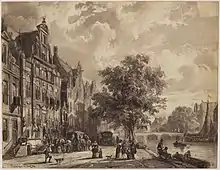
by Cornelis Springer
In 1733 he married Alida Jacoba Hilken with whom he had eight children.[48] In 1735 he cooperated with his brother Johannes (IV) to promote the trade with Sweden. Spanish pieces of eight were used to produce silver ingots that were shipped on the Rooswijk, which sank in 1740.[49] In 1742 both brothers lived separately on Herengracht;[50] they each owned a chaise and two horses.[51] In 1747 they sold the silver melting business at the end of Spiegelgracht, and concentrated on banking and assurance on ships and goods for customers in Sweden.[52][53] Around 1751, they moved into the "Huis met de Hoofden" which they rented from the descendants of Louis De Geer. He wrote twice a week to Stockholm.[54] When Johannes died – with whom he shared many bills of exchange – Anthoni Grill became the only heir and his other siblings were bequeathed.[55]
The trading house in Amsterdam wrote a bill for the amount for which it bought goods from a Swedish seller. The seller could then obtain money by selling the bill to someone who wanted to buy goods, in Amsterdam or elsewhere, and use the bill to pay for them. Importers and exporters both bought bills, to pay and to obtain money. Bills that were not cashed immediately earned interest. A bill that was transferred before it matured was sold at a discount. The interest due from the transfer date up to maturity was deducted from the bill's nominal value. The higher the rate of interest, the larger the discount.[56]
During the Seven Years' War France gave a total of 11 million sd. in subsidies to Sweden.[57] In 1759, Anthoni lodged Bengt Ferner, a Swedish astronomer and mathematician, who kept a diary about his travels in Holland. Accompanied by Jacob Grill, Ferner visited the mint in Utrecht and Harderwijk, run by inlaws.[58] During the Amsterdam banking crisis of 1763, he was considerably involved in the bankruptcy of Leendert Pieter de Neufville, who failed to come to an agreement with his bankers.[59] Their financial situation of the clearinghouse deteriorated, because of fluctuating exchange rates in the recent past.[60] In the meantime the name of the bank changed to Antoni Grill & Soonen. In 1768, as in 1736, the Swedish mystic, inventor and mining specialist Emanuel Swedenborg visited Grill.[61] In 1773, Anthoni became owner of the Garphyttan factories when the previous owner (Michael Grubb) failed to repay the money he had borrowed from him.[62] To be able to manage the factories, his sons Jacob (1734–1799), Abraham (1735–1805) and Anthony Grill Jr (1743–1805) moved to Stockholm.[7] Their sister Helena Catharina (1739–1804) owned a quarter in the profitable "La Jalousie" plantation along the Commewijne River and stayed in business.[63] Both her father and Helena were buried in Amsterdam.[64]
Claes Grill (I)
_-_Nationalmuseum_-_15726.tif.jpg.webp)
Claes Grill (19 April 1705 – 6 November 1767) was the son of Abraham (I) Grill and Helena Wittmack and twin brother to Anthoni (IV), with whom he cooperated. Claes married his uncle Carlos' daughter, Anna Johanna (I) Grill (1720–1778). They had two children, Adolf Ulric, collector and natural scientist, and a daughter named Anna Johanna (II).[lower-alpha 19] In 1739 he became a member of the Swedish Academy of Sciences.
Claes was a merchant, factory owner and ship-owner. He was director of the Grill Trading House, one of the leading companies in the East India trade through the Swedish East India Company (SOIC). On his wharf a number of the ships for the SOIC were built.[39] The trading house also ran a banking business and insured shares in ships and goods. At the death of Carlos in 1736, Claes (I) was sole owner of the company until his half-brother Johan Abraham joined him as partner in 1747. In 1748 he bought the anchor-works at Söderfors. He owned already the ironworks in Iggesund; the Dutch Republic was the main destination of bar iron, but after 1750 it was France. He imported salt from Portugal and the Mediterranean, silver, tobacco and paintings from the Netherlands, and shipbuilding material (pitch, tar, cloth, hemp and planks) from the Baltic countries.[66] He had three agents in Rouen, but Marseille became a staple market to distribute the Swedish products in all Mediterranean regions.[67] Grill also owned several estates in Uppland and a house at Norrmalmstorg.
Claes had an unsuccessful political career. In December 1747 he was appointed in the Växelkontoret (Exchange Office), a financial institution created to stabilize exchange rates of the Swedish currency. In the same month Grill was appointed in the Association of Ironmasters. The same men ruled both institutions and that created opportunities for private initiative and abuse of power.[68] In 1749 he promoted a Swedish merchant fleet. In 1753 he was appointed in the SOIC. During the winter and spring months of 1757–1758 the Stockholm bills of exchange market ran out of control. The Exchange office survived until the beginning of 1761.[69] The associates obtained a compensation over 2 million for their expenses. In March 1765 the Caps launched a legal investigation of Claes and Johan Abraham Grill, etc. In 1766 Claes was fined, together with half-brother. They were accused of conscious mismanagement of the office for their own profit.[70] The Grills sentenced to pay back half a million to the Riksen Ständers Bank. Claes Grill lost his civil and burgher rights.[71] His widow continued to run the Trading House; her son Adolf Ulrich took over the business in 1778.
Abraham Grill (II) the Younger
Abraham Grill (28 January 1707 – 28 January 1768) was the son of Abraham (I) and brother of Anthoni (IV), Claes (I), and half-brother to Johan Abraham.[72] He started his career as Swedish consul in Helsingør in 1733 to 1736.[7] During his time in Denmark he met Anna Maria Petersen, and they were married in 1735. They had thirteen children of which five died at an early age.[38]
Abraham and his family moved to Gothenburg in 1746, where he established a trading house. That year, he was also one of the directors for the SOIC during the second charter.[73] He cooperated closely with the two other trading houses in the Grill family at that time: Carlos & Claes Grill in Stockholm and Anthony & Johannes Grill in Amsterdam. Abraham's trading house handled most of the copper exported from Gothenburg during a few years in the 1760s. The company also exported iron and tea, brought to Gothenburg by the SOIC.[8]
One of Abraham's many children, Lorentz Grill, became his partner in the trading house in 1761.[74] At the death of Abraham (on his birthday) in 1768, Lorentz sought out new partners and continued running the company.[8]
Johan Abraham Grill
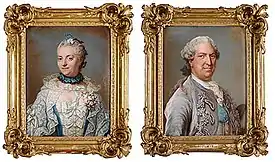
Johan Abraham Grill (1719 – 16 March 1799) was a Swedish merchant and politician. He was the son of Abraham (I), the Elder, and Katarina Rozelius, his third wife. He was a half-brother to Claes (I), Abraham (II) and uncle to Jean Abraham.[43] He married Christina Elisabeth Fischer (1731–1805). It was Johan Abraham who introduced a motto for the Grill family: Ärlighet warar längst (Honesty is the best policy.).[38]
In 1747, Johan Abraham became partner in the Grill Trading House. Throughout his career he held a number of official positions and received several awards. In 1763, he became a board member in the Jernkontoret (Association of Ironmasters), established in 1747, it is the oldest trade association in Sweden.[75] In 1767, he was a member of the Sjöförsäkringsrätten (The Naval Insurance Court) where he handled disputes related to shipping that could not be settled in any other way.[76] With the third charter, he became director of the SOIC in 1770.[77] At the same time he was an accountant and also responsible for credits and loans issued from the Swedish State to various companies.[43][78]
Johan Abraham was a member of the hat party and helped finance the Swedish court and the hats activity in the Riksdag 1771–72, especially in connection to King Gustav III's coup d'état on 19 August 1772, whereby the king's power was solidified.[79] The money for the coup had to be smuggled out from the Grill House in Stockholm, to the Royal castle in double bottom, wooden troughs filled with mortar.[75] Johan Abraham continued to run the Trading House after Claes (I)'s death in 1767. In 1799, Johan Abraham died and the company went bankrupt.[41]
Jacob Grill
Jacob Grill (1734 – 1799) was a Swedish ironworks owner. He was born in Amsterdam, the son of Anthoni Grill (IV). He never married and had no children.[38]
In 1759 he accompanied Bengt Ferner on his travel through the Netherlands. In 1769, Jacob became the owner of the Skebo and Ortala ironworks, the Norrtälje gun factory and the Männäis blast furnace in Nykyrka, Åbo, when the previous owner was forced to sell due to financial difficulties.[80] During his time at Skebo, Jacob built the Skebo Manor in 1767 to 1770.[81] Jacob moved to Sweden with his brothers when his father became owner of the Garphyttan ironworks.[7] He was very inexperienced in how to operate the ironworks, and they gradually became the property of his lender, the Tottie & Arfwedson Trading House, and in 1782, the transfer was complete. Jacob moved to Broby, then Graneberg and finally to Nyköping where he died penniless.[80]
Jean Abraham Grill
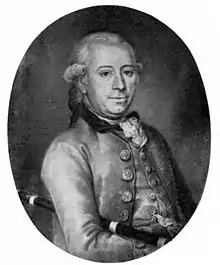
Jean Abraham Grill (21 July 1736 – 12 March 1792), sometimes called Johan Abraham Grill, was a Swedish merchant, supercargo and director of the SOIC as well as an ironmaster. Jean Abraham was the oldest son of merchant Abraham (II), and Anna Maria Petersen.[82]
In 1753 he joined the trading house. He journeyed to China twice in 1755 and 1761. (In between he lived in France.) He lived in Canton as well as Macao for eight years.[83] He was the representative in Canton for the SOIC, because of the Canton System. Since 1732 Swedish merchants traded in Canton now known as Guangzhou. He also had two trading companies, one together with Michael Grubb,[84] trading with the countries close to China, and one of his own, which he used for trading tea and smuggling opium from India to China.[85]
When he returned to Sweden, he bought from De Geer family the Godegård ironworks and manor, along with several other ironworks, that he renovated and improved.[86][82] All his notes, correspondence, accounts, cargo lists and books are preserved in the Godegård Archive.[87]
Claes Grill (II)
Claes Grill (2 September 1750 – 2 August 1816) was a Swedish merchant. He was the son of Abraham Grill (II). In 1770, he settled down in London, where he met and married Maria Hackson. They had three children.[38]
In 1770, Claes became partner in the Anglo-Swedish company Andrew & Charles Lindegren, a London-based importer of Swedish iron. Andrew & Charles Lindegren traded with the Carlos & Claes Grill (the Grill Trading House) and was the major supplier of iron to the British East India Company.[88] The name of the company was changed first to Lindegren & Grill, and later to Lindegren son & Grill. By that name, the company continued to serve as an agent for the East India Company in Portsmouth.[8]
Claes became Counsel General to London in 1786 to 1815,[8] Both he and William Chalmers applied for that position, but Claes was better known in the London society, had lived longer in England and was connected to a large trading house. By the time he died in Chelsea in 1816, Claes was also partners with a merchant, Harrison, in London.[89]
Adolf Ulric Grill
_-_Nationalmuseum_-_17964.tif.jpg.webp)
Adolf (Adolph) Ulric Grill (19 March 1752 – 1 October 1797) was a Swedish ironworks owner and scientific collector of animals and fossils for his cabinet of curiosities at Söderfors. He married his cousin, Anna Johanna (III) (1753–1809) in Stockholm on 7 June 1778, they had one son who died at an early age. At the time of his marriage, Adolf Ulric lived in the Grill house in Stockholm. He and his wife moved to Söderfors when he inherited the ironworks and manor from his father Claes (I) in 1767. In Söderfors, he established a zoological museum which, at the time, was the largest collection in the Nordic countries.[90]
Estates, mansions and factories
These are some of the estates and factories owned by members of the Grill family or by the Grill Trading House during the 18th and 19th century.[91]
The Grill house, Stockholm
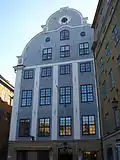
The Grill House at Stortorget 3 in Gamla stan, Stockholm was built during the Middle Ages and thoroughly converted in 1649. Although subsequently remodeled in 1750 and 1914, the large molded baroque gable and some of the painted joists date to the 17th century conversion. The classic lesene of the facade and some of the interior are from the mid 18th century. It acquired its name in the 17th century when the house was purchased by Anthoni Grill (II).[7] The Grill family owned the house for more than two hundred years and as of 2013, it houses the Stockholms Stadsmission (The Stockholm City Mission).[91][92]
The Grill mansion, Uppsala

The Grill family (possibly Claes Grill (I)) started to build the Grill manor in central Uppsala after the great fire in 1766. At the time, the family owned ironworks at Söderfors and Österby in Uppland, as well as at Iggesund in Hälsingland. The estate was completed in 1770. The Grill family owned the manor until 1790. It is the only preserved town manor in Uppsala. As of 2013, it houses apartments and offices for the Red cross and Save the Children.[93][94]
The Lennart Torstensons palace
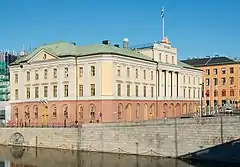
Claes Grill (I) bought the palace in 1764, and lived there until he died in 1767, after which it was passed on to his wife Anna Johanna (I), and later their daughter Anna Johanna (II). In 1783, it was bought by Princess Sophia Albertina and converted into a part of the Arvfurstens palats.[95] As of 1906 it houses the Swedish Ministry for Foreign Affairs.[96]
Svindersvik
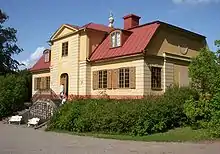
Built by Claes Grill (I), the residence was designed by architect Carl Hårleman in the early 1740s. It is one of Sweden's oldest preserved country residences. Claes and his wife Anna Johanna (I), would live in Stockholm during the winter and spend the summers at Svindersvik. The residence was usually accessed by boat. The style of the residence is rococo, with many Chinese elements. At the death of Claes (I), the estate was passed on to his daughter Anna Johanna (II). The house was sold in 1780, and passed through several owners, until it was bought by silk manufacturer K.A. Almgren in 1863. As of 1949, the house is owned by the Nordic Museum.[97]
Söderfors


The Grill's estate in Söderfors largely made up the entire town at that time along with the ironworks and the manor. The ironworks were founded in 1676 to make anchors. Claes Grill (I) bought the ironworks in 1748, and it stayed within the Grill family until 1907.[98] The factory passed through several owners and is, since 1995, owned and operated by Scana Steel Söderfors AB, a company with production in Norway, Sweden and China.[99]
The first manor was finished in 1700 then between 1749 and 1756 it was rebuilt by architect Carl Hårleman for Claes Grill (I). After his death, the manor passed to his son Adolf Ulric. He was an avid naturalist and during his residence he filled it with art and specimens of mounted animals, minerals, fossils and plants.[98] Adolph Ulric had a separate house built for his collection in 1786. He also started the construction of an English garden at Söderfors by the river Dalälven. Gustaf af Sillén completed the park, which is one of the main features in Söderfors.[100] As of 2014, the manor is a hotel and conference venue. On 20 December 1985, most of the ironworks and the surrounding area of Söderfors, a total of 91 buildings, became listed buildings, making it one of the largest listed sites in Sweden.[101] [102]
Österbybruk


The ironworks at Österbybruk were established by King Gustav I of Sweden with the help of German experts during the 16th century and specialised in making munitions. During the 17th century the factories were merged with Lövsta and Gimo, under the directions of Louis De Geer, making it the second largest ironworks in Sweden.[103] Since De Geer recruited skilled iron workers from the Walloon Region of Belgium, these ironworks became known as the Walloon factories ("Wallonbruken").[104] The iron ore processed in Österby came from the Dannemora mine and was noted for its purity. Iron bars produced at these ironworks were stamped with a "Double Bullet" mark, which guaranteed high and consistent quality. Such iron became reputable in England, where it was used by the steel industry in Sheffield.[105] In 1758, the ironworks was sold to the Grill Trading house, at that time owned by Claes (I) and Johan Abraham. The trading house was discontinued with the death of Johan Abraham in 1799, and the ironworks was sold to Anna Johanna (III), the wife of Adolf Ulric.[106] The factory passed through several owners until it was closed in 1983.[107]
In 1763, Claes (I) started construction of the mansion at Österbybruk. The mansion incorporated the two wings already built in the 1730s; the west wing which served as housing for one of the ironworks caretakers and the east wing containing a chapel. The mansion was not completed until 1780, due to the decline of the East India trade, accusations of financial misconduct against Claes and Johan Abraham and the banking crises in Amsterdam in 1763.[108] As of 2014, the manor is owned by the Bruno Liljefors Foundation. His studio in one of the buildings is preserved and is on occasion open to the public.[104]
Iggesunds bruk
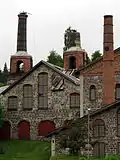
The ironworks at Iggesund is predated by a sawmill established by the Swedish state in 1572. The first ironworks were established in 1685, by the trader Isak Breant, the Elder. It included a blast furnace, a forge with a trip hammer and two finery forges. The iron ore came from Utö and the Dannemora mine.[109] After the Russians burned Iggesund down during raids along the Swedish coastline in 1721, the ironworks was bought by the Grill Trading House. The Grills successfully ran and improved the factories during most of the 18th century.[110] With the decline of the Trading House in 1800, the ironworks went through several owners until it was sold to the owners of Österbybruk at that time. During the 20th century the ironworks were, through several owners, transformed and diversified into a sawmill, pulp and paper industry, chemical plant, dairy and agricultural companies. As of 1988, Iggesunds bruk is a part of Iggesund Paperboard.[109]
Godegård

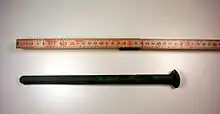
The Grill's estates at the village of Godegård, the manor and the ironworks, dominated the community during the 18th century. Mining had been done in the area as early as in the Middle Ages, and by the early 17th century, an ironworks was already established at Godegård. The ironworks was bought by Louis De Geer in 1618. He improved and expanded the factories and recruited skilled Walloons iron workers to teach the Swedes how to use a finery forge.[111] When he died, the ironworks and the first manor passed on to his son Jean De Geer. After a fire in 1719, the new manor was built. It was completed in 1725.[112]
Settling down in Sweden after his profitable journeys to China, Jean Abraham was looking for something to invest in. He started negotiations for the purchase of land, manor and factory at Godegård, at that time the largest ironworks in Östergötland, and bought them all in 1775.[82] Jean Abraham continued the expansion of the ironworks and made significant restoration of the manor. He also built an English garden, designed by Fredrik Magnus Piper, with several gazebos in a Chinese style.[111] The ironworks was closed in 1896, but the manor remained in the Grill family until 1980. It became a listed building in 1977.[113] Jean Abraham collected all of his letters, accounts and notes in an archive at Godegård, now known as the Godegård Archive. As of 2003, the archive, containing over 7,000 document, is in the Nordic Museum. It has been digitized and is available on line as result of a request from the Macau Historical Archives in 2003.[87]
Mariedamm
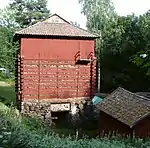
The Trehörnings blast furnace in Mariedamm was originally built by local miners in 1636. Louis De Geer bought it in 1648, and it became part of the Godegårds ironworks which was sold on to Jean Abraham in 1775. The blast furnace remained a part of the Grill's estate at Godegård until 1888, when it was sold to the Skyllbergs bruk. The blast furnace was in operation until 1889. Since 1923, it is in being cared for and renovated by the Lerbäck Heritage society.[114] At the beginning of the 19th century, a mansion was built in Mariedamm by the Grill family. The mansion was demolished in the 1920s, only one of the wings remain.[115]
Garphyttan

The mining at Garphyttan was started during the Middle Ages by German miners. These were called "garps", a medieval Swedish word meaning "loudmouths" or "braggers".[116] The main product was lead ore which also contained silver, but the yield from the ore was small and business faltered a number of times during the 17th century . It was not until the factory was bought by three Dutch merchants in 1661, that the company started to flourish again. A trip hammer, two hearths, a smithy, a saw mill, a silver refinery and housing for the workers were added. The factories and the ironworks went through several owners until 1773, when Abraham (III) acquired them all. The previous owner, Michael Grubb, had borrowed money from the Anthony Grill & Sons Trading House in Amsterdam, and when he failed to repay the loan in 1774, the factories became the property of the Grills.[117] The building of a manor at Garphyttan started during the 17th century, and several additions were made in the middle of the 18th century. The main building of the manor was destroyed during a fire in 1830, only the four wings remain.[62]
Stora Nyckelviken

Stora Nyckelviken manor was completed in 1746 by Herman Petersen, a wealthy merchant and director of the SOIC. The manor was designed in much the same style as the other manors built with the profits from the East India trade. It consists of a main building, wings, gazebos and a park. The manor was only owned by the Grill family for a short period of time. Jean Abraham Grill bought it in 1760, and sold it 20 years later.[91] As of 2014 the manor is owned by the municipality of Nacka. It houses a restaurant and a conference venue.[118]
Skebo and Ortala
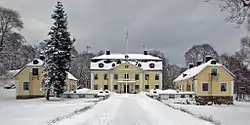

The first ironworks in Skebo was built in the 15th century. The iron ore was mined locally in the forests surrounding the factory. The first smithy with a trip hammer at Skebo, was constructed by Hindrich Lemmens in 1626. The iron from the ironworks was mainly sold to the Norrtälje rifle factory, which made weapons used in the Thirty Years' War. During the 18th century the Skebo and Ortala (a similar mine and factory nearby) ironworks were operated jointly. They went through several owners, due to the economical entanglements and financial difficulties of the directors and investors. One of these affairs resulted in Jacob Grill obtaining Skebo and Ortala, along with three other factories in 1769, from the previous owner who could not pay his debt to Jacob.[91] Jacob had no experience in operating an ironworks, he got into financial difficulties and had to sell the factories in 1782. The ironworks flourished during the 19th century, and began to decline after 1900, ending in bankruptcy in 1924.[81]
During his time at Skebo, Jacob built a manor in 1767–1770. During the 19th century the new owners filled it with art and sculptures and it became a center for the local socialite. When the ironworks folded the manor became a retirement home for elderly gentlemen, a spa, a house for seminars and workshops, and in 2010, a noted restaurant listed in the White Guide 2012.[119] As of 2013, the restaurant is closed and the manor is a temporary lodging for refugees seeking asylum in Sweden.[120]
The Lövåsen lead and silver factory

The Lövåsen lead and silver factory in Stora Skedvi was one of the first factories to be connected with the Grill family. The Swedish government handed over the administration of the factory to Anthoni Grill (I) in 1656, to be used as a laboratory and workshop by him. He had claimed that he was in possession of a secret "matter" that would enable him to extract much more copper, lead, silver and gold from the ore than by other conventional methods. He experimented fore some years at the laboratory, but he never improved the extraction process, and was consequently demoted from his position at the mine. As of 2014, there are no visible remains of the mine or the factory.[7]
Ersta

Ersta is one of the many malmgårdarna (suburban manors) built in Stockholm during the 17th and 18th century. At these manors, wealthy, noble families from different parts of Sweden, could enjoy the same comforts as in their homes in the country. The manors were built in the suburbs, close to what constituted Stockholm in the 17th century and 18th century. The city has grown considerably since then, and these locations are now considered to be part of central Stockholm. Many of the buildings, the entire manor or part of them, are still in use and embedded in the modern cityscape.[121]
Ersta, on the high cliffs of southern Stockholm, was probably built in the 1670s by brännvin manufacturer Oluf Håkansson. At that time the land in that area was cheap since it was close to the old gallows. When the gallows was moved further away from town to make way for a new shipyard, the Stora Stads wharf, where ships for the SOIC were built, the area around Ersta became sought after and was called "a garden". The mansion passed through several owners until Jean Abraham Grill bought it in 1755. In 1770, he established a crucible steel factory at Ersta with the help of Bengt Andersson Qvist, a member of the Swedish Board of Mines. Members of the Qvist family were inspectors at the Iggesund ironworks.[91] The steel was of good quality, but nevertheless unprofitable. In 1775, Jean Abraham sold the manor and the steel factory to Qvist who ran the company until it folded with his death in 1799.[122] As of 2014, only two of the buildings at the manor remain. They are a part of the Ersta Hospital and one of them houses the Ersta museum.[123]
Notes
- The swallow-tailed version of the Swedish flag was used on the ships of the SOIC even though the use of such a flag was prohibited. Only ships in the Swedish Navy were entitled to fly a (triple-)tailed flag. The SOIC ships used the two-tailed version, that looked like a navy flag, to discourage pirates at sea. Despite the prohibition, Claes Grill (I) ordered several flags in Canton.[3] He even used them at his summer residence, Svindersvik, on land and on the rowboat taking him to and from the house. One of these flags remained at Svindersvik and is one of the oldest, preserved flags in Sweden. As of 2014 it is kept at the Livrustkammaren.[4]
- A grey crane on a golden field, looking left, standing with one foot on three black stones surrounded by foliage.[6]
- His portrait is preserved in a miniature silver relief kept in the collections of the Amsterdam Museum.[14]
- Elias van Wolffswinckel
- 1616–1679
- which went broke
- The other surviving children were Rosina (1635), Lysbeth (1636–1693), Johanna (1642), Catharina (1644), Balthasar (1646–1697) and Johannes II (1649–1673)
- Probably derived from the German word Goldscheider, schied being an old word for "separate".[22] Swedish has many loanwords from German and sometimes they are just made to sound Swedish even if the meaning becomes distorted.
- A skedare worked with professional purification/extraction of precious metals.
- Anthoni (III), Catharina (1666–1739), Johannes (III) (1668–1734), Maria (1673–1732), Isaak (1676–1698), Dorothea (−1717) and Sophia (1682–1766).
- Around 1782 the painting was recanvassed by Erik Hallblad, who added an extra sword.[27] It was then shown in the Swedish Academy of Fine Arts. In 1785 it was transported to Stockholm Palace. Since 1864, the painting is kept in the Nationalmuseum, Stockholm.
- In 1746 their son Nicolaas Anthoni was appointed as prosecutor in Surinam. In January 1648 he married the daughter of governor Jan Jacob Mauricius. It probably explains why several members of the Grill family were involved in the plantation "La Jalousie" during the second half of the 18th century.
- In 1784 Sofia's daughter Maria Dorothea Kohl declared in her will that her niece in Stockholm, Anna Maria Gemnich, whose grandmother was Anna Maria Grill, would be her only heir.[28]
- His predecessors were his uncle Johannes (1614–1670), appointed in 1663 as assayer at the Wisselbank, who was also the father of his wife, her brothers Johannes (1647–1673) and Elias (1655–1681), her brother-in-law Andries Gallus (1656–1706) and in 1700 her nephew Pieter Bartels.[29]
- In a collective item on the profit and loss accounts
- At first assayers were allowed to keep 5% then 10% of the profit as provision.
- He was in contact with another collector Nicolaes Witsen. In 1726, Johannes (III) Grill bought for 2.7 million guilders and sold for around 1.7 million guilders, a total cash turnover of 4.4 million guilders.[36]
- Terra Nova is Latin for "new land" and refers to the reclaimed land it was built upon.[39]
- The foundation of the Österby collection was formed in the late 18th century by the merchant and ironmaster Henrik Wilhelm Peill (1730–1797) and his wife Anna Johanna Grill (1745–1801), who resided in the manor of Österbybruk in Uppland. As the protégé of Count Carl Gustaf Tessin, Henrik Wilhelm Peill came to Paris in the 1760s during his educational tour in Europe where he met the well-known portrait painter Alexander Roslin and his wife Marie Suzanne Giroust. Peill, who on his mother's side was related to the family of artist Martin Mijtens the Elder, became a close friend to Roslin. When he returned home he married Anna Johanna Grill.[65]
References
- "En praktfull ostindisk servis med det grillska vapnet" [A splendid East India tableware with the Grill coat of arms]. www.digitaltmuseum.se. Digitalt Museum—Nordic Museum. Retrieved 27 July 2014.
- Peter Ericsson & Patrik Winton (2018) Politics of Credit: The Market for Government Debt in Sweden, 1715–60, pp. 16–17
- Kjellberg 1975, pp. 174–176.
- Söderberg, Bengt G. (1968). Slott och herresäten i Sverige. Södermanland [Castles and manors in Sweden. Södermanland] (in Swedish). Malmö: Allhems förlag. pp. 170–171. SELIBR 483512.
- "Grilliana – En sida om släkten Grill" [Grillology – An article about the Grill family] (PDF). www.grilliana.wordpress.com. The Grill family. Retrieved 17 December 2019.
- Schöldström, Birger (1879). "Ett fosterländskt Bildergalleri" [A patriotic picture gallery.]. Svenska Familj-Journalen (in Swedish). Stockholm: Svenska Familj-Journalen via Project Runeberg. 18: 325–327.
- "Grill, släkt" [Grill, family]. Svenskt biografiskt lexikon (in Swedish). 17. Stockholm: National Archives of Sweden. 1967–1969. p. 276.
- Svensson, Anders. "Abraham Grill". gamlagoteborg.se. Det Gamla Göteborg. Retrieved 14 September 2014.
- "Skeppsbroadeln" [Skeppsbro nobility]. www.ne.se (in Swedish). Nationalencyklopedin. Retrieved 16 September 2014.
- van Eeghen, Isabella Henriette; Schönbeck-Salzer, Elisabeth (translator). "Grill's Hofje – Grillska Stiftelsen" (PDF). Grilliana. Retrieved 1 December 2019.
- Fisher, Alexander J. (2017). "Augsburg in the Reformation and Counter-Reformation". Music and Religious Identity in Counter-Reformation Augsburg, 1580–1630. St Andrews Studies in Reformation History. Routledge. ISBN 9781351916394.
- "Ondertrouwregisters 1565–1811". Gemeente Amsterdam Stadsarchief. Retrieved 1 December 2019.
- "Ondertrouwregisters 1565–1811". Gemeente Amsterdam Stadsarchief. Retrieved 1 December 2019.
- "Portretminiatuur van Johannes Grill, 1643". Amsterdam Museum. hdl:11259/collection.33968. Cite journal requires
|journal=(help) - Dillen, J.G. van (1929). "Deel III 1633–1672, nr 208, 292, 620". Bronnen tot de geschiedenis van het bedrijfsleven en het gildewezen van Amsterdam 1510–1672. Huygens Institute for the History of the Netherlands.
- Lambour, R. (2005). "De alchemistische wereld van Galenus Abrahamsz (1622-1706)". In J.J. Bosma (ed.). Doopsgezinde Bijdragen (nieuwe reeks 31 ed.). Amsterdam: Uitgeverij Verloren. pp. 117–122. ISBN 90-6550-902-X.
- Principe, L.M (2014). "Laboratories of Art: Alchemy and Art Technology from Antiquity to the 18th". In Dupré, Sven (ed.). Laboratories of Art: Alchemy and Art Technology from Antiquity to the 18th Century. Springer Science+Business Media. pp. 167–169. ISBN 9783319050652.
- Geisst, Charles R. (2005). Encyclopedia of American business history. New York. p. 39. ISBN 978-0-8160-4350-7.
- Thomas Marmefelt (2015) Seventeenth Century Banking: Amsterdamsche Wisselbank, Stockholms Banco, and Their Consequences for Monetary Evolution, p. 14
- Plate Money
- "Goldscheider". www.geschichtewiki.wien.gv. Wien Geschichte Wiki. Retrieved 11 December 2019.
- Patterson, Austin McDowell. (1917). "Goldscheider, TO. gold refiner, gold parter.". A German-English dictionary for chemists. New York: John Wiley & Sons, Inc. p. 112. Retrieved 11 December 2019.
- Lindroth, Sten (1967–1969). "Baltzar Grill". Svenskt biografiskt lexikon (in Swedish). 17. Stockholm: National Archives of Sweden. p. 278. Retrieved 10 December 2019.
- Müller 1998, p. 201.
- Bille, Clara (1956). "Rembrandt's Claudius Civilis and its owners in the 18th century". Oud Holland. Brill Publishers. 71 (1): 54–58. doi:10.1163/187501756X00073. JSTOR 42711857.
- Cavalli-Björkman 2010, p. 412
- "Het Archief van de Amsterdamse Notarissen". www.akten.amsterdam.nl. Stadsarchief Amsterdam. Retrieved 6 December 2019.
- van Eeghen, Isabella Henriette (1970). Het Grill's hofje. Jaarboek Amstelodamum. pp. 49–86.
- Bronnen tot de geschiedenis der wisselbanken (Amsterdam, Middelburg, Delft, Rotterdam). Deel I, p. 694
- Scheffers, Albert Antoine Jacques (18 April 2013). "Om de kwaliteit van het geld. Het toezicht op de muntproductie in de Republiek en de voorziening van kleingeld in Holland en West-Friesland in de achttiende eeuw". www.leidenuniv.nl. Leiden University Institute for History, Faculty of Humanities, Leiden University. pp. 60, 361, 416. Retrieved 5 December 2019.
- Marmefelt, T. (2015) Seventeenth Century Banking: Amsterdamsche Wisselbank, Stockholms Banco, and Their Consequences for Monetary Evolution, p. 22, 14.
- Dehing 2012, pp. 185–186.
- "Grill's Hofje". www.hofjesinamsterdam.nl. Amsterdamse Hofjes. Retrieved 1 December 2019.
- Grill, Anthony (1728). Catalogus Van Een Extraordinair Schoon en Uytmuntendt Kabinet Van Veelderlei Ongemene Rariteiten ...
- Dehing 2012, p. 139.
- Abraham Grill, https://sok.riksarkivet.se/sbl/artikel/13192 Swedish biographical dictionary (art by Staffan Högberg) from 2 December 2019]
- Grill, Johan Wilhelm; Grillo Ankarswärd, Karl (1951). Conceptbok till Grillska släktens historia [The Grill family history] (PDF) (in Swedish). Godegård: Mårten Persson. Retrieved 20 August 2014.
- Zethelius 1956, p. 59.
- "Strandvägshamnen" [Port at Strandvägen]. www.stockholmshamnar.se. Stockholms Hamn. Retrieved 14 September 2014.
- "Handelshuset Carlos & Claes Grill (1716–1799)" [The Carlos & Claes Grill Trading House (1716–1799)]. www.riksarkivet.se/. National Archives of Sweden. Retrieved 14 September 2014.
- Müller 1998, p. 194.
- Meijer Bernhard; Westrin Theodor; Berg Ruben G:son; Söderberg Verner; Fahlstedt Eugène, eds. (1909). "Grill". Nordisk familjebok–Uggleupplagan (in Swedish). Stockholm: Nordisk familjeboks förl. pp. 303–304.
- Müller 1998, p. 257-258.
- Evans, Chris; Rydén, Göran (2007). Baltic iron in the Atlantic world in the eighteenth century. The Atlantic World: Europe, Africa And The Americas, 1500 – 1830, Band 13 von The Atlantic World. Leiden: Brill Publishers. p. 306. ISBN 9789004161535.
- Pol, Arent (1985). "Tot gerieff van India, geldexport door de VOC en de muntproduktie in Nederland 1720–1740" (PDF). Jaarbook voor munt- en penningkunde. Jaarboek voor Munt- en Penningkunde : Heruitgave van de Tijdschriften ... En de Jaarboeken ... Voor Munt- en Penningkunde (72 ed.). Amsterdam: Koninklijk Nederlands Genootscap voor munt- en penningkunde. ISSN 0920-380X.
- Röell, Guus (2017). "Uit verre streken – from distant shores – Luxury goods from Dutch trading posts in the West Indies, East Indies, China, Japan and Africa – 17th – 19th Centuries" (PDF). www.guusroell.com. Maastricht: Guus Röell. Retrieved 5 December 2019.
- "Doopregisters voor 1811". Gemeente Amsterdam Stadsarchief. Retrieved 1 December 2019.
- Petrou, Peter. "Silver VOC – Dutch East India Company – Ingot". www.peterpetrou.com. Peter Petrou. Retrieved 5 December 2019.
- de la Fontaine Verwey, H.; van Eeghen, I.H.; Roosegaarde Bischop, G.; Wijnman, H.F. (1976). Vier eeuwen Herengracht: Geveltekeningen van alle huizen aan de gracht, twee historische overzichten en de beschrijving van elk pand met zijn eigenaars en bewoners. Amsterdam: Stadsdrukkerij. ISBN 978-9062740017.
- Het kohier van de personeele quotisatie te Amsterdam over 1742 (Amsterdam 1945)
- "Transportakten voor 1811". Gemeente Amsterdam Stadsarchief. Retrieved 1 December 2019.
- Müller 1998, p. 210, 216.
- Müller 1998, p. 238.
- Grill, Johannis. "Registration on October 11, 1754 – Will of Johannis Grill". www.openarch.nl. Coret Genealogy. Retrieved 3 December 2019.
- Riksbanken Age of Liberty. A conservative resurgence
- Winton 2012, p. 24.
- Kernkamp, G.W.; Ferrner, Bengt (1910). "Bengt Ferrner's dagboek van zijne reis door Nederland in 1759". Bijdragen en Mededeelingen van Het Historisch Genootschap. Digital Library for Dutch Literature. 31: 314. Retrieved 1 December 2019.
- de Jong-Keesing, Elisabeth Emmy (1939). De Economische crisis van 1763 te Amsterdam. Intern. uitgevers en H. Stuj. p. 109.
- Müller 1998, p. 64, 152, 216.
- Emanuel Swedenborg, Secret Agent on Earth and in Heaven: Ed. by Marsha Keith Schuchard (2012), p. 337, 664
- Nachmanson, August; Hannerberg, David (1945). Garphyttan: ett gammalt bruks historia [Garphyttan: the history of an old orinworks] (in Swedish). Stockholm: Bonnier. SELIBR 26310.
- van de Voort, Johannes Petrus (1973). De Westindiche plantages van 1720 tot 1795 – Financiën en handel (PDF). Eindhoven: Drukkerij de witte.
- "Begraafregisters voor 1811". Gemeente Amsterdam Stadsarchief. Retrieved 3 December 2019.
- Uppsala Auktionskammare
- Müller 1998, pp. 125–138.
- Trade between France and Sweden in the Eighteenth Century by Pierrick Pourchasse, p. 107, 110
- Müller 2002, pp. 128-133.
- Müller 2002, pp. 136-137.
- Müller 2002, p. 128.
- Müller 2002, p. 144.
- "Het Archief van de Amsterdamse Notarissen". www.akten.amsterdam.nl. Stadsarchief Amsterdam. Retrieved 7 December 2019.
- Kjellberg 1975, p. 165.
- Müller 1998, p. 235.
- Hofberg, Herman, ed. (1906). "Grill, Klas". Svenskt biografiskt handlexikon (in Swedish). 1. Stockholm: Svenskt biografiskt handlexikon via Project Runeberg. pp. 402–403. Retrieved 20 August 2014.
- "Kungl. Sjöförsäkringsöverrätten (1750–1866)" [The Naval Insurance Court (1750–1866]. www.riksarkivet.se/. National Archives of Sweden. Retrieved 12 August 2014.
- Kjellberg 1975, p. 166.
- "Generaldiskontkontoret bildades 1787 som..." [The General Credit's Office was established in 1787 as...]. svenskuppslagsbok.se. Svensk uppslagsbok. Retrieved 12 August 2014.
- Gunnar Carlquist, ed. (1932). "Gustav III". Svensk uppslagsbok. Malmö: Baltiska förl. SELIBR 1335380.
- Norrby, Jonas (1991). Jennings (in Swedish). Vällingby: Statens vattenfallverk. ISBN 91-7186-288-9. SELIBR 7617104.
- "Ett av Upplands äldsta järnbruk" [One of the oldest ironworks in Uppland]. www.skebobruksmuseum.se. Skebobruks Museum. Archived from the original on 27 November 2013. Retrieved 28 August 2014.
- Högberg, Staffan (1967–1969). "Johan Abraham Grill". Svenskt biografiskt lexikon (in Swedish). 17. Stockholm: National Archives of Sweden. p. 285. Retrieved 23 September 2014.
- The Self-Perception of Early Modern Capitalists by M. Jacob, C. Secretan, p. 130
- "Grubb, släkt" [Grubb, family]. Svenskt biografiskt lexikon (in Swedish). 17. Stockholm: National Archives of Sweden. 1967–1969. p. 341. Retrieved 24 September 2014.
- Kjellberg 1975, p. 111.
- Frängsmyr 1990, p. 104.
- Gram, Magdalena. "Svenska Ostindiska Kompaniet" [Swedish East India CompanyI]. ostindiska.nordiskamuseet.se. Nordic Museum. Retrieved 25 August 2014.
- Müller, Leos (2007). Dickson, David; Parmentier, Jan; Ohlmeyer, Jane H (eds.). Irish and Scottish mercantile networks in Europe and overseas in the seventeenth and eighteenth centuries. Gent: Academia Press. p. 162. ISBN 978-90-382-1022-3.
- Samuelsson, Kurt (1951). De stora köpmanshusen i Stockholm 1730–1815: en studie i den svenska handelskapitalismens historia [The grand trading houses in Stockholm 1730–1815: a study in the history of Swedish trade capitalism] (in Swedish). Stockholm: Ekonomisk-historiska institutet i Stockholm. pp. 46–50. SELIBR 8074825.
- Sjöberg, Sven (1967–1969). "Adolph Ulric Grill". Svenskt biografiskt lexikon (in Swedish). 17. Stockholm: National Archives of Sweden. p. 288.
- Persson, Mårten. "Några av släkten Grills gods och gårdar" [Some of the Grill's houses and manors.] (PDF). www.grilliana.files.wordpress.com. The Grill family. Retrieved 27 July 2014.
- Gledin, Ewa. "Om Grillska Huset" [About the Grill house]. www.stadsmissionen.se. Stockholms Stadsmission. Retrieved 27 July 2014.
- "Kakelugn från 1700-talet i Grillska garden" [A cocklestove from the 1700s in the Grill manor.]. www.digitaltmuseum.se. Digitalt Museum—Upplandsmuseet. Retrieved 27 July 2014.
- Ehn, Ola (1984). "Grillska gården i Uppsala" [The Grill manor in Uppsala]. Uppsala: Upplandsmuseet. Retrieved 27 July 2014. Cite journal requires
|journal=(help) - Ellehag, Claes (1998). Palatsen i Stockholm under stormaktstiden [The Palaces in Stockholm during the Swedish Empire]. Böcker om konst (Signum), 99-0345976-9 (in Swedish). Lund: Signum. pp. 126–128. ISBN 91-87896-38-9. SELIBR 7767599.
- "Arvfurstens palats". www.sfv.se. Statens Fastighetsverk. Retrieved 10 August 2014.
- "A rococo style country residence". www.nordiskamuseet.se. Nordic Museum. Retrieved 10 August 2014.
- Fritz Martin, ed. (1976). Söderfors 300 år (in Swedish). Falun: Stora Kopparbergs bergslags AB. pp. 37–49. SELIBR 129674.
- "Scana Steel Söderfors". www.scana.no. Scana. Archived from the original on 14 October 2014. Retrieved 10 August 2014.
- "Engelska parken i Söderfors bruk" [The English garden at Söderfors.]. www.lansstyrelsen.se. Länsstyrelsen Uppsala län. Retrieved 10 August 2014.
- "Tierp Söderfors bruk". www.bebyggelseregistret.raa.se. Swedish National Heritage Board. Retrieved 10 August 2014.
- "Welcome to Söderfors Herrgård". www.soderforsherrgard.se. Söderfors Herrgård. Retrieved 10 August 2014.
- Dahlgren, Erik Wilhelm (1928). De uppländska bruken Österby, Forsmark, Leufsta och Gimo under äldsta tider [The Upplandic ironworks Österby, Forsmark, Leufsta and Gimo during the elder days] (in Swedish). Stockholm. SELIBR 1488887.
- Högström, Leif. "Österbybruk" (PDF). www.vallonbruken.nu. Vallonbruk i Uppland med Länsstyrelsen i Uppsala län. Retrieved 20 August 2014.
- Hildebrand, Bengt; Högberg, Staffan (1967–1969). "Claes Grill". Svenskt biografiskt lexikon (in Swedish). 17. Stockholm: National Archives of Sweden. p. 281. Retrieved 21 September 2014.
- Tham, Wilhelm (1850). Beskrifning öfver Sveriges rike. Bd 1. H. 3, Beskrifning öfver Upsala län [Description of the land of Sweden. Description of Upsala county] (in Swedish). Stockholm: C. A. Bagge. SELIBR 387888.
- "Österbybruk". www.svetur.se. Visit Roslagen. Retrieved 20 August 2014.
- Hildebrand, Bengt (1967–1969). "Claes Grill". Svenskt biografiskt lexikon (in Swedish). 17. Stockholm: National Archives of Sweden. p. 281.
- Klingström, Lars. "Holmen 400 år, 1609–2009". www.holmen.com. Holmen. Retrieved 24 August 2014.
- "Hudiksvalls bruksminnen". www.bruksminnen.com. The Hudiksvalls Bruksminnen Foundation. Archived from the original on 2 February 2007. Retrieved 24 August 2014.
- Ekinge, Robert. "Louis De Geer". www.ekinge.nu. Robert Ekinge. Retrieved 24 August 2014.
- "Godegård". Nordisk familjebok (in Swedish). 5. Stockholm: Project Runeberg. 1800. pp. 1333–4.
- "Godegårds säteri". www.bebyggelseregistret.raa.se. Swedish National Heritage Board. Retrieved 25 August 2014.
- "Trehörnings masugn" [The Trehörnings blast furnace]. www.lansstyrelsen.se. Länsstyrelsen Örebro län. Retrieved 26 August 2014.
- Persson, Mårten (2007). "Andreas Gustaf Grill – bergsman och entreprenör" [Andreas Gustaf Grill – miner and entrepreneur]. D-dissertation at the History Dep. Of the Lund University.
- "Garp". Nordisk familjebok (in Swedish). 9. Stockholm: Project Runeberg. 1908. pp. 764–4.
- Müller, Leos (2008). ""Merchants" and "Gentlemen" in Eighteenth-Century Sweden. Worlds of Jean Abraham Grill". In Jacob, Margaret C.; Secretan, Catherine (eds.). The Self-Perception of Early Modern Capitalists. London: Palgrave Macmillan. pp. 138–139. ISBN 978-0-230-60447-6.
- "Stora Nyckelviken". www.stockholmslansmuseum.se. Stockholms läns museum. Retrieved 27 August 2014.
- "Detta har hänt" [The story so far]. skeboherrgard.se. Skebo Herrgård. Archived from the original on 30 December 2013. Retrieved 28 August 2014.
- Andersson, Ki. "Skebo herrgård tillfällig bostad för flyktingar" [Skebo manor temporary home for refugees]. norrteljetidning.se. Norrtelje Tidning. Retrieved 28 August 2014.
- Lindberg, Birgit (1985). Malmgårdarna i Stockholm [The suburban manors of Stockholm]. Stockholm: LiberFörlag. p. 16. ISBN 91-38-90418-7. SELIBR 7268833.
- Lindberg, Birgit (1985). Malmgårdarna i Stockholm [Suburban manors of Stockholm]. Stockholm: LiberFörlag. pp. 45–48. ISBN 91-38-90418-7. SELIBR 7268833.
- "Hur staden på berget växte fram" [How the city on the mountain came to be]. www.erstadiakoni.se. Ersta diakoni. Retrieved 28 August 2014.
Bibliography
- Dehing, P. (2012). Geld in Amsterdam. Wisselbank en wisselkoersen, 1650–1725. Faculty of Humanities, Amsterdam Institute for Humanities Research, University of Amsterdam. hdl:11245/1.378147. ISBN 978-90-8704-311-7.
- Frängsmyr, Tore (1990). Ostindiska kompaniet: människorna, äventyret och den ekonomiska drömmen [The Swedish East India company: the people, the adventure and the economic dream] (in Swedish) (2 ed.). Höganäs: Wiken. ISBN 91-7024-653-X. SELIBR 7591876.
- Kjellberg, Sven T. (1975). Svenska ostindiska compagnierna 1731–1813: kryddor, te, porslin, siden [The Swedish East India company 1731–1813: spice, tea, porcelain, silk] (in Swedish) (2 ed.). Malmö: Allhem. ISBN 91-7004-058-3. SELIBR 107047.
- Lindqvist, Herman (2002). Historien om ostindiefararna [The story of the East Indiamen] (in Swedish). Gothenburg: Hansson & Lundvall. ISBN 91-85023-02-7. SELIBR 8843398.
- Müller, Leos (1998). The merchant houses of Stockholm, c. 1640–1800: a comparative study of early-modern entrepreneurial behavior. Studia historica Upsaliensia, 0081-6531 ; 188Studia historica Upsaliensia, 0081-6531 ; 188. Uppsala: Acta Universitatis Upsaliensis. ISBN 91-554-4233-1. SELIBR 8359550.
- Müller, Leos (2002). "Economic policy in eighteenth-century Sweden and early modern entrepreneurial behaviour. A case of the Exchange Office". In de Goey, Ferry; Veluwenkamp, Jan Willem (eds.). Entrepreneurs and Institutions in Europe and Asia, 1500-2000. Amsterdam: Aksant. ISBN 9052600325.
Further reading
- Ahlander, Björn; Langert, Jens (2009). Skeppsboken – livet ombord på en Ostindiefarare [The ship's log – life aboard an East Indiaman] (in Swedish). Göteborg: Svenska ostindiska companiet. ISBN 978-91-633-4889-1. SELIBR 11607831.
- Arensberg, Ingrid (2009). Ostindiefararen Götheborg seglar igen [The Swedish ship Götheborg sails again] (in Swedish and English). Göteborg: Svenska ostindiska companiet. ISBN 978-91-633-4846-4. SELIBR 11614816.
- Campbell, Colin; Hallberg, Paul; Koninckx, Christian (1996). A passage to China: Colin Campbell's diary of the first Swedish East India Company expedition to Canton, 1732–33. Acta Regiae Societatis scientiarum et litterarum Gothoburgensis. Humaniora, 0072-4823 ; 37. Gothenburg: Royal Society of Arts and Sciences (Kungl. Vetenskaps- och vitterhets-samhället). ISBN 91-85252-55-7. SELIBR 7747182.
External links
| Wikimedia Commons has media related to The Grill mansion, Uppsala. |
| Wikimedia Commons has media related to Grill's Hofje (Amsterdam). |
| Wikimedia Commons has media related to Svindersvik. |
| Wikimedia Commons has media related to Söderfors bruk. |
| Wikimedia Commons has media related to Österbybruk. |